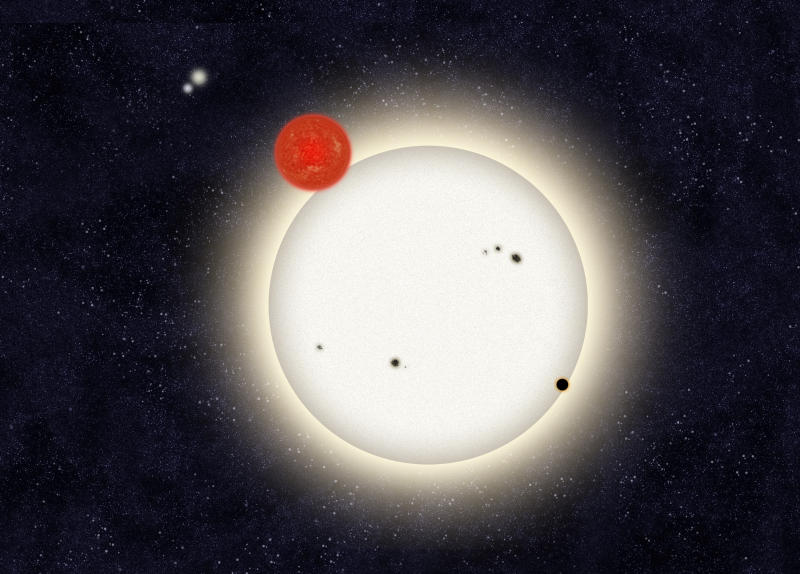Armchair astronomers find planet in four-star system
October 17, 2012

The PH1 planetary system. The newly discovered planet (large black circle) is shown in this artist’s rendition transiting the larger of the two stars (white and red circles) it orbits. Off in the distance (upper left), well beyond the planet orbit, is a second pair of stars bound to the planetary system. (Credit: Haven Giguere/Yale)
A joint effort of citizen scientists and professional astronomers has led to the first reported case of a planet orbiting twin suns that are orbited by a second distant pair of stars.
Aided by volunteers using the Planethunters.org website, a Yale-led international team of astronomers identified and confirmed discovery of the phenomenon, called a circumbinary planet in a four-star system.
Only six planets are known to orbit two stars, according to researchers, and none of these are orbited by distant stellar companions.
“The discovery of these systems is forcing us to go back to the drawing board to understand how such planets can assemble and evolve in these dynamically challenging environments,” said Meg Schwamb of Yale, lead author of a paper about the system.
Dubbed PH1, the planet was first identified by citizen scientists participating in Planet Hunters, a Yale-led program that enlists members of the public to review astronomical data from NASA’s Kepler spacecraft for signs of planets. It is the project’s first confirmed planet discovery.
The volunteers — Kian Jek of San Francisco and Robert Gagliano of Cottonwood, Arizona — spotted faint dips in light caused by the planet as it passed in front of its parent stars, a common method of finding extrasolar planets. Schwamb, a Yale postdoctoral researcher, led the team of professional astronomers that confirmed the discovery and characterized the planet, following observations from the Keck telescopes on Mauna Kea, Hawaii. PH1 is a gas giant with a radius about 6.2 times that of Earth, making it a bit bigger than Neptune.
PH1 orbits outside the 20-day orbit of a pair of eclipsing stars that are 1.5 and 0.41 times the mass of the Sun. It revolves around its host stars roughly every 138 days. Beyond the planet’s orbit at about 1000 AU (roughly 1000 times the distance between Earth and the Sun) is a second pair of stars orbiting the planetary system.
“The thousands of people who are involved with Planet Hunters are performing a valuable service,” said coauthor Jerome Orosz, associate professor of astronomy at San Diego State University. “Many of the automated techniques used to find interesting features in the Kepler data don’t always work as efficiently as we would like.”
The research was supported by NASA and the National Science Foundation Astronomy and Astrophysics Postdoctoral Fellowship.